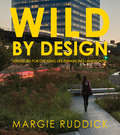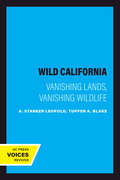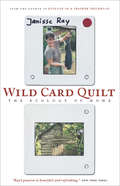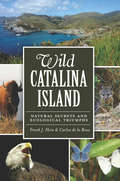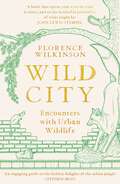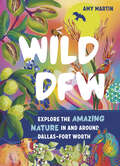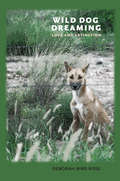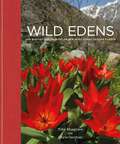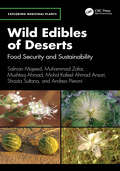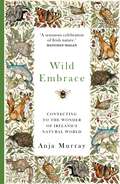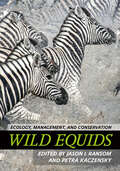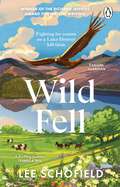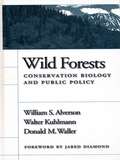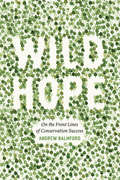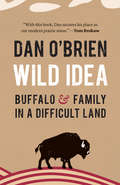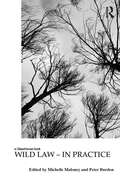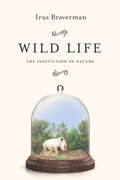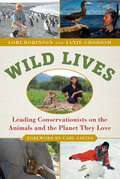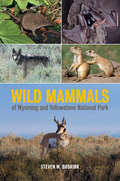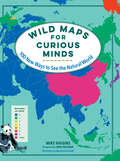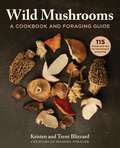- Table View
- List View
Wild By Design: Strategies for Creating Life-Enhancing Landscapes
by Margie RuddickCan nature--in all its unruly wildness--be an integral part of creative landscape design? In her beautifully illustrated book, Wild by Design, award-winning designer Margie Ruddick urges designers to look beyond the rules often imposed by both landscaping convention and sustainability checklists. Instead, she offers a set of principles for a more creative and intuitive approach that challenges the entrenched belief that natural processes cannot complement high-level landscape design.Wild by Design defines and explains the five fundamental strategies Ruddick employs, often in combination, to give life, beauty, and meaning to landscapes: Reinvention, Restoration, Conservation, Regeneration, and Expression. Drawing on her own projects--from New York City's Queens Plaza, formerly a concrete jungle of traffic, to a desertscape backyard in Baja, California, to the Living Water Park in Chengdu, China--she offers guidance on creating beautiful, healthy landscapes that successfully reconnect people with larger natural systems.A revealing look into the approach of one of sustainable landscape design's most innovative practitioners, Wild by Design stretches the boundaries of landscape design, offering readers a set of broader, more flexible strategies and practical examples that allow for the unexpected exuberance of nature to be a welcome part of our gardens, parks, backyards, and cities.
Wild California: Vanishing Lands, Vanishing Wildlife
by A. Starker LeopoldThe universal spread of civilization has encompassed the wildness of California. While some of the original ecosystems have been preserved, others have been reduced to tattered remnants. Rich and varied habitats, with their plants and animals, are gone forever, destroyed by the conversion of valley lands to agriculture, the damming of streams, the cutting of forests, the paving of meadows. Wild California makes a persuasive argument for identifying and protecting areas of unspoiled California before they disappear. This is a stunning photographic guide to the six major California regions--from the Sierra Nevada to the desert--and their wildlife. To A. Starker Leopold, conservationist, naturalist, wildlife biologist, and educator, the delicate balance between plants, animals, and humans in each community is precious and fragile. In a highly readable style that mingles authority and eloquence, Leopold reminds us of th aesthetic, educational, and scientific values of undeveloped land. Tupper Ansel Blake, naturalist and wildlife photographer, has contributed one hundred color images that marvelously convey the special beauties of this state. Fortunately, the rich legacy of early California can still be found, and Tupper Blake's images with Starker Leopold's words are powerful evidence that this wilderness is worth preserving for future generations.
Wild Card Quilt: The Ecology of Home (The\world As Home Ser.)
by Janisse RayThis account of rediscovering her Georgia home and its landscapes is “another must-read book” by the author of Ecology of a Cracker Childhood (Tulsa World).Seventeen years after she’d left “for good,” Janisse Ray pointed her truck away from Montana and back to the small southern town where she was born. Wild Card Quilt is the story, by turns hilarious, heartbreaking, and ambitious, of the adventures of returning home. For Ray, a naturalist and an American Book Award–winning author, it is a story of linking the ecology of people with the ecology of place—of recovering lost traditions as she works to restore the fractured ecosystem of her native South. Her story is filled with syrup boils, quilt making, alligator trapping, and the wonderful characters of a place where generations still succeed each other on the land. But her town is also in need of repair, physical and otherwise. This memoir recounts Ray’s journey as she works to save her local school, sets up a writing group at the local hardware store—and struggles with whether she can be an adult in a childhood place.“Alive with good imagery and colorful characters.” —The Atlanta Journal-Constitution“This is nature writing at its best . . . Her book will make you long for home.” —St. Petersburg Times
Wild Catalina Island: Natural Secrets and Ecological Triumphs (Natural History)
by Carlos de la Rosa Frank J. HeinA year-round escape for one million annual tourists, Catalina Island is gaining popularity as a world-class eco-destination. Eighty-eight percent of the island is under the watch of the Catalina Island Conservancy, which preserves, manages and restores the island's unique wild lands. Bison, foxes and bald eagles are its best-known inhabitants, but Catalina is home to more than sixty other animal and plant species that exist nowhere else on earth. And they are all within the boundaries of one of the world's most populous regions: Los Angeles County. Biologists Frank Hein and Carlos de la Rosa present a highly enjoyable tour through the fascinating origins, mysterious quirks and ecological victories of one of the West Coast's most remarkable places.
Wild City: Encounters With Urban Wildlife
by Florence Wilkinson'The mark of a good nature book is that it opens your eyes to what is there, but you missed, and then to the beautiful possibility of what might be. This is a very good book.' John Lewis-Stempel'An enjoyable and timely reminder that we are never alone' Tristan GooleyThe badgers of Brighton's most exclusive postcode. The water voles of Glasgow. The Black Country bats who have found a haven in old industrial tunnels. The peregrine falcons nesting on the ledges of tower blocks. The mosquitoes found on the London Underground and nowhere else on earth.In Wild City Florence Wilkinson takes us on a fascinating journey into why we should engage with our fellow urban species. What we might see - if we only take the time to look - and how nature is adapting to human-engineered environments in unexpected and ingenious ways.As more and more of our planet is urbanised, we humans still feel that primal pull to connect with our wilder roots. This gorgeously lyrical book invites us to celebrate the natural world, while also offering a clear-eyed glimpse into the challenges faced by urban plants and animals as cities grow and sprawl.Wild City proposes a compelling manifesto for city wildlife, suggesting how we might take action to protect the often-overlooked residents who live alongside us.City-dwellers, it's time to meet your neighbours.
Wild DFW: Explore the Amazing Nature In and Around Dallas–Fort Worth (Wild Ser.)
by Amy MartinDiscover all the unexpected nature Dallas-Fort Worth has to offer with this enlightening guidebook! Dallas-Fort Worth is more than just a bustling metroplex, it&’s full of amazing wildlife. You just need to know where to find it! Equal parts natural history, field guide, and trip planner, Wild DFW has something for everyone. This handy yet extensive guide looks at the factors that shape local nature and profiles over 100 local species, from American basket-flowers and pecan trees to bald eagles, nine-banded armadillos, and Texas spiny lizards. Twenty-five day trips help you find and explore these natural wonders on hiking trails, in public parks, and in your own backyard.
Wild Dog Dreaming: Love and Extinction (Under the Sign of Nature: Explorations in Ecocriticism)
by Deborah Bird RoseWe are living in the midst of the Earth's sixth great extinction event, the first one caused by a single species: our own. In Wild Dog Dreaming, Deborah Bird Rose explores what constitutes an ethical relationship with nonhuman others in this era of loss. She asks, Who are we, as a species? How do we fit into the Earth's systems? Amidst so much change, how do we find our way into new stories to guide us? Rose explores these questions in the form of a dialogue between science and the humanities. Drawing on her conversations with Aboriginal people, for whom questions of extinction are up-close and very personal, Rose develops a mode of exposition that is dialogical, philosophical, and open-ended.An inspiration for Rose--and a touchstone throughout her book--is the endangered dingo of Australia. The dingo is not the first animal to face extinction, but its story is particularly disturbing because the threat to its future is being actively engineered by humans. The brazenness with which the dingo is being wiped out sheds valuable, and chilling, light on the likely fate of countless other animal and plant species."People save what they love," observed Michael Soulé, the great conservation biologist. We must ask whether we, as humans, are capable of loving--and therefore capable of caring for--the animals and plants that are disappearing in a cascade of extinctions. Wild Dog Dreaming engages this question, and the result is a bold account of the entangled ethics of love, contingency, and desire.
Wild Edens
by Chris Gardner Toby MusgraveOrnamental plants are the cornerstone of our gardens and we are spoiled for choice with literally tens of thousands of hardy beauties from which to select. But we take them absolutely for granted, not for a moment realising that every plant has a fascinating tale to tell. Wild Edens sets the record straight. With global coverage, each of the nine richly illustrated chapters explores a plant biodiversity hotspot. The reader is transported on a visually stunning and fascinating voyage of discovery which reveals our garden favourites - as well as some species that should be more widely cultivated - in their natural habitats, from daffodils from Andalusia and tulips from the Tien Shan, to monkey puzzles from Chile and rhododendrons from the Himalayas, lilies from Japan and proteas from South Africa.Because the authors have been to the hotspots, each chapter opens with their personal reflections on the landscape and spirit of place, and closes with their selection of prime locations. In between, the informative yet approachable text tells of the plants' 'forgotten stories'. Of the landscapes which are their home, the adventures of how and when they were discovered and by whom, the reasons why they were collected, their impact on garden fashions and trends, etc. Wild Edens brings another dimension of interest and understanding to plants and gardens, as well as being a premium armchair traveller's guide to the natural world of garden plants.
Wild Edibles of Deserts: Food Security and Sustainability (Exploring Medicinal Plants)
by Mushtaq Ahmad Muhammad Zafar Andrea Pieroni Shazia Sultana Mohd Kafeel Ansari Salman MajeedGlobal Wild Edibles of Deserts: Food Security and Sustainability provides coverage of topics in food and health in desert rangelands, using an interdisciplinary approach that considers health not only in a functional and human sense, but also in terms of external factors including aridity.The plant diversity in desert ecosystems provide economic service benefits, such as sources of fodder, fuel wood, and traditional medicinal plants. This book documents wild edibles commonly grown in deserts that are hugely beneficial for the herbal industry for the socio-economic uplift of local communities. This book contains multiple field pictorial graphs of desert wild edible plants to help with their identification, and it gives detailed information on food security issues and sustainability measures in the world desert zones. It also focusses on the diversity of wild edibles in deserts across the globe, their nutraceutical importance, production-consumption trends, integration into food menus, and marketing and livelihood opportunities to the indigenous people.A volume in the Exploring Medicinal Plants series, this book creates opportunity for policymakers to develop plans for the successful entry of wild edibles into herbal industries, and attracts farmers owning infertile lands to cultivate wild edibles in desert rangeland. The book is a valuable resource for researchers, conservationists, and policymakers seeking solutions at the intersection of food security and environmental sustainability.
Wild Embrace: Connecting to the Wonder of Ireland's Natural World
by Anja Murray'Gorgeous ... a joyful reminder that there are still wonders to be found in Ireland wherever we give nature an inch to flourish' IRISH INDEPENDENT'From moss to moths, Anja Murray has conjured up an ebullient paean to our surrounding ecosystem - a sensuous celebration of nature.' MANCHÁN MAGAN'A hugely important, and simply delightful, book.' EOGHAN DALTUN, author of An Irish Atlantic RainforestOPEN UP TO A NOURISHING NEW RELATIONSHIP WITH IRELAND'S WILD WORLD.Wild Embrace is about cultivating curiosity and awe in nature, in a time of eco-anxiety and overwhelm. As ecologist Anja Murray opens our eyes to the hidden bounty of the land, sea and sky around us, we head out on a unique journey through the Irish landscape.She explores the joy of foraging, the marvels of Irish birds, the roles of our native trees in environmental regeneration, nature at night and in the city, and much more - including fascinating insights into our ecological past.With beautiful illustrations by Jane Carkill (@lamblittle), Wild Embrace awakens our senses to the everyday environmental wonders within reach, as we set out on a path to empowered change into the future.
Wild Embrace: Connecting to the Wonder of Ireland's Natural World
by Anja Murray'Gorgeous ... a joyful reminder that there are still wonders to be found in Ireland wherever we give nature an inch to flourish' IRISH INDEPENDENT'From moss to moths, Anja Murray has conjured up an ebullient paean to our surrounding ecosystem - a sensuous celebration of nature.' MANCHÁN MAGAN'A hugely important, and simply delightful, book.' EOGHAN DALTUN, author of An Irish Atlantic RainforestOPEN UP TO A NOURISHING NEW RELATIONSHIP WITH IRELAND'S WILD WORLD.Wild Embrace is about cultivating curiosity and awe in nature, in a time of eco-anxiety and overwhelm. As ecologist Anja Murray opens our eyes to the hidden bounty of the land, sea and sky around us, we head out on a unique journey through the Irish landscape.She explores the joy of foraging, the marvels of Irish birds, the roles of our native trees in environmental regeneration, nature at night and in the city, and much more - including fascinating insights into our ecological past.With beautiful illustrations by Jane Carkill (@lamblittle), Wild Embrace awakens our senses to the everyday environmental wonders within reach, as we set out on a path to empowered change into the future.
Wild Equids: Ecology, Management, and Conservation
by Jason I. Ransom Petra KaczenskyThe first expert synthesis of the diverse studies conducted on wild equids worldwide.Wild horses, zebras, asses, and feral equines exhibit intriguing and complex social structures that captivate the human imagination and elicit a wide range of emotions that influence conservation and management efforts. This book, spearheaded by Jason I. Ransom and Petra Kaczensky, brings together the world's leading experts on equid ecology, management, and conservation to provide a synthesis of what is known about these iconic species and what needs to be done to prevent losing some of them altogether. The most comprehensive conservation book on wild equids in decades, this title will enlighten not only equid researchers, but also mammalogists, conservationists, and equine professionals. Readers will find new insight into the lives of the world's horses, zebras, and asses, understand the basis of our relationships with these animals, and develop a greater understanding of where equids come from and why they are worth conserving.Included in this book are detailed, state-of-the-science syntheses on Social structure, behavior, and cognition Habitat and diet Ecological niches Population dynamics Roles of humans in horse distribution through time Human dimensions and the meaning of wild Management of free-roaming horses Captive breeding of wild equids Conservation of wild equids Conservation of migrations Reintroductions Genetics and paleogenetics
Wild Fell: Fighting for nature on a Lake District hill farm
by Lee Schofield'I found myself turning the pages with an inward leap of joy' - Isabella Tree*WINNER of the Richard Jefferies Award for Nature Writing**Shortlisted for the James Cropper Wainwright Prize for Conservation*'Exquisite' GUARDIANIt was a tragic day for the nation's wildlife when England's last and loneliest golden eagle died in an unmarked spot among the remote eastern fells of the Lake District. But the fight to restore the landscape had already begun.Lee Schofield, ecologist and site manager for RSPB Haweswater, is leading efforts to breathe life back into two hill farms and their thirty square kilometres of sprawling upland habitat.Informed by the land, its turbulent history and the people who have shaped it, Lee and his team are repairing damaged wetlands, meadows and woods. Each year, the landscape is becoming richer, wilder and better able to withstand the shocks of a changing climate.But in the contested landscape of the Lake District, change is not always welcomed, and success relies on finding a balance between rewilding and respecting cherished farming traditions. This is not only a story of an ecosystem in recovery, it is also the story of Lee's personal connection to place, and the highs and lows of working for nature amid fierce opposition.
Wild Forests: Conservation Biology And Public Policy
by Don Waller Walter Kuhlmann William S. AlversonWild Forests presents a coherent review of the scientific and policy issues surrounding biological diversity in the context of contemporary public forest management. The authors examine past and current practices of forest management and provide a comprehensive overview of known and suspected threats to diversity. In addition to discussing general ecological principles, the authors evaluate specific approaches to forest management that have been proposed to ameliorate diversity losses. They present one such policy -- the Dominant Use Zoning Model incorporating an integrated network of "Diversity Maintenance Areas" -- and describe their attempts to persuade the U.S. Forest Service to adopt such a policy in Wisconsin. Drawing on experience in the field, in negotiations, and in court, the authors analyze the ways in which federal agencies are coping with the mandates of conservation biology and suggest reforms that could better address these important issues. Throughout, they argue that wild or unengineered conditions are those that are most likely to foster a return to the species richness that we once enjoyed.
Wild Hope: On the Front Lines of Conservation Success
by Andrew BalmfordTropical deforestation. The collapse of fisheries. Unprecedented levels of species extinction. Faced with the plethora of gloom-and-doom headlines about the natural world, we might think that environmental disaster is inevitable. But is there any good news about the environment? Yes, there is, answers Andrew Balmford in Wild Hope, and he offers several powerful stories of successful conservation to prove it. This tragedy is still avoidable, and there are many reasons for hope if we find inspiration in stories of effective environmental recovery. Wild Hope is organized geographically, with each chapter taking readers to extraordinary places to meet conservation’s heroes and foot soldiers—and to discover the new ideas they are generating about how to make conservation work on our hungry and crowded planet. The journey starts in the floodplains of Assam, where dedicated rangers and exceptionally tolerant villagers have together helped bring Indian rhinos back from the brink of extinction. In the pine forests of the Carolinas, we learn why plantation owners came to resent rare woodpeckers—and what persuaded them to change their minds. In South Africa, Balmford investigates how invading alien plants have been drinking the country dry, and how the Southern Hemisphere’s biggest conservation program is now simultaneously restoring the rivers, saving species, and creating tens of thousands of jobs. The conservation problems Balmford encounters are as diverse as the people and their actions, but together they offer common themes and specific lessons on how to win the battle of conservation—and the one essential ingredient, Balmford shows, is most definitely hope. Wild Hope, though optimistic, is a clear-eyed view of the difficulties and challenges of conservation. Balmford is fully aware of failed conservation efforts and systematic flaws that make conservation difficult, but he offers here innovative solutions and powerful stories of citizens, governments, and corporations coming together to implement them. A global tour of people and programs working for the planet, Wild Hope is an emboldening green journey.
Wild Horses: Running Free (Orca Wild #11)
by Linda L. RichardsKey Selling Points This book is controversial in that it challenges the accepted theory that wild horses were introduced to North America by Spanish explorers, when in fact, new research shows they may have been in North America all along. Wild horses, and mustangs in particular, are an iconic symbol of the American West. Young people have played a major role in protecting wild horses all over the world and Wild Horses highlights their important work. Wild horses are under threat as their protections have been stripped away by the US government in recent years. This is a story of conservation and ecology and features examples of how wild horses are being protected all over the world. The author is a self-proclaimed horsewoman who, as a child, thought she had tamed her own mustang. She took most of the photos in this book herself.
Wild Idea: Buffalo and Family in a Difficult Land
by Dan O'BrienFor more than forty years the prairies of South Dakota have been Dan O’Brien’s home. Working as a writer and an endangered-species biologist, he became convinced that returning grass-fed, free-roaming buffalo to the grasslands of the northern plains would return natural balance to the region and reestablish the undulating prairie lost through poor land management and overzealous farming. In 1998 he bought his first buffalo and began the task of converting a little cattle ranch into an ethically run buffalo ranch. Wild Idea is a book about how good food choices can influence federal policies and the integrity of our food system, and about the dignity and strength of a legendary American animal. It is also a book about people: the daughter coming to womanhood in a hard landscape, the friend and ranch hand who suffers great tragedy, the venture capitalist who sees hope and opportunity in a struggling buffalo business, and the husband and wife behind the ranch who struggle daily, wondering if what they are doing will ever be enough to make a difference. At its center, Wild Idea is about a family and the people and animals that surround them—all trying to build a healthy life in a big, beautiful, and sometimes dangerous land.
Wild Law
by Cormac CullinanCullinan, CEO of an environmental law and policy consultancy in Cape Town, South Africa, presents the second edition of his ambitious 2003 volume outlining his vision of a legal system based on the laws of nature rather than those of an industry-based, man-made society. He begins by demonstrating the current human-centric state of man's relationship with nature, in which we view ourselves as separate, independent, and dominant; continues to posit an alternative view inspired by climate science and indigenous cultures, wherein we are interdependent with and reliant upon the natural world; and proceeds to employ political theory, legal history, science, and contemporary philosophy in service of his theory of Earth Jurisprudence and Earth Governance, which questions everything from property ownership, to the modern concept of time, to the legal rights of trees. Annotation ©2011 Book News, Inc. , Portland, OR (booknews. com)
Wild Law - In Practice (Law, Justice and Ecology #4)
by Peter Burdon Michelle MaloneyWild Law - In Practice aims to facilitate the transition of Earth Jurisprudence from theory into practice. Earth Jurisprudence is an emerging philosophy of law, coined by cultural historian and geologian Thomas Berry. It seeks to analyse the contribution of law in constructing, maintaining and perpetuating anthropocentrism and addresses the ways in which this orientation can be undermined and ultimately eliminated. In place of anthropocentrism, Earth Jurisprudence advocates an interpretation of law based on the ecocentric concept of an Earth community that includes both human and nonhuman entities. Addressing topics that include a critique of the effectiveness of environmental law in protecting the environment, developments in domestic/constitutional law recognising the rights of nature, and the regulation of sustainability, Wild Law - In Practice is the first book to focus specifically on the practical legal implications of Earth Jurisprudence.
Wild Life: The Institution of Nature
by Irus BravermanWild Life documents a nuanced understanding of the wild versus captive divide in species conservation. It also documents the emerging understanding that all forms of wild nature—both in situ (on-site) and ex situ (in captivity)—may need to be managed in perpetuity. Providing a unique window into the high-stakes world of nature conservation, Irus Braverman describes the heroic efforts by conservationists to save wild life. Yet in the shadows of such dedication and persistence in saving the life of species, Wild Life also finds sacrifice and death. Such life and death stories outline the modern struggle to define what conservation should look like at a time when the long-established definitions of nature have collapsed. Wild Life begins with the plight of a tiny endangered snail, and ends with the rehabilitation of an entire island. Interwoven between its pages are stories about golden lion tamarins in Brazil, black-footed ferrets in the American Plains, Sumatran rhinos in Indonesia, Tasmanian devils in Australia, and many more creatures both human and nonhuman. Braverman draws on interviews with more than one hundred and twenty conservation biologists, zoologists, zoo professionals, government officials, and wildlife managers to explore the various perspectives on in situ and ex situ conservation and the blurring of the lines between them.
Wild Lives: Leading Conservationists on the Animals and the Planet They Love
by Carl Safina Janie Chodosh Lori RobinsonToday we are faced with the alarming possibility that as many as 50 percent of species alive will become extinct within this century. This statistic is so staggering that scientists have begun to refer to the twenty-first century as the ?sixth extinction.” But while this is alarming, all hope is not lost; conservation experts across the globe are working tirelessly to preserve our planet for future generations. In Wild Lives, twenty of these pioneers share their stories via exclusive interviews. Coming from different countries, diverse cultures, a variety of socio-economic backgrounds, and specializing in different species, all of these conservationists have an important characteristic in common: they have committed their lives to saving our planet and the majestic species that call it home. Some of these esteemed contributors include: Today we are faced with the staggering possibility that as many as 50 percent of species alive will become extinct within this century. This statistic is so staggering that scientists have begun to refer to the twenty-first century as the ?sixth extinction.” But while this is alarming, all hope is not lost; conservation experts across the globe are working tirelessly to preserve our planet for future generations. Beverly and Dereck Joubert, National Geographic filmmakers and big cat experts Ric O’Barry, dolphin advocate and trainer of Flipper George Schaller, famed field biologist and author Yossi Leshem, Israeli ornithologist Dominique Bikaba, gorilla activist Paul Hilton, award-winning wildlife photographer Passionate and inspiring, Wild Lives is an important and timely reminder of the beauty and fragility of our world and the obligation that every person has towards preserving it.
Wild Mammals of Wyoming and Yellowstone National Park
by Steven W. BuskirkWild Mammals of Wyoming and Yellowstone National Park provides the scholar, conservationist, and interested lay reader with information on the state's 117 wild mammalian species from grizzly bears to pygmy shrews. It describes the history of mammalogy in Wyoming, the zoogeography of Wyoming mammals, and the prehistoric mammals of Wyoming. It also characterizes the habitats of Wyoming mammals and addresses the conservation and management of mammals in the region. Expanding beyond the traditional field guide, Steven W. Buskirk emphasizes taxonomic classification, geographic range, and conservation status for mammalian species. Introductory sections are provided for each order and family, and individual species accounts organize a wealth of data ranging from habitat associations to field measurements in an easy-to-use format. Featuring color species photos, continental and state-scale distribution maps, and a comprehensive bibliography with nearly 1,000 references, Wild Mammals of Wyoming and Yellowstone National Park is an indispensable resource for wildlife and conservation biologists and mammalogists working in this region.
Wild Maps for Curious Minds: 100 New Ways To See The Natural World (Maps for Curious Minds #0)
by Mike HigginsThe natural world has never been wilder—with 100 fiercely fun, curiously captivating, and amazingly adventurous maps Which nations have launched animals into space? Where are the world’s cat people? How many humans live in high-risk zones for natural disasters? How far do you have to travel to hug all fifteen of the world’s oldest trees? Where in the world do snakes live—or better yet, where can you avoid them?! Find the thought-provoking answers to these questions and many more in Wild Maps for Curious Minds. This infographic atlas of nature’s most impressive wonders and eye-popping oddities is bursting with discovery (Where’s the most remote place on Earth?), whimsical insight (Which animals have launched into space?), and startling revelations (How much forest have we destroyed?) that will change the way you see the natural world—and that celebrate our planet and the plants and animals with whom we share it.
Wild Mushrooms: A Cookbook and Foraging Guide
by Kristen Blizzard Trent BlizzardGet ready to fall in love with wild mushrooms! Absolutely everything you need to know to make mushrooming a lifestyle choice, from finding, storing, preserving, and preparing common and unusual species. Packed with content and lore from more than 20 skilled foragers around the country, Wild Mushrooms will help mushroom hunters successfully utilize their harvest, and includes practical information on transporting, cleaning, and preserving their finds. One of the best things about cooking wild mushrooms is that every time you open your dried caches, their unique aroma recalls your foraging experience creating an immediate and visceral connection back to the forest. There is no finer way to appreciate food. You will not only learn the best ways to locate, clean, collect, and preserve your mushrooms from the experts, the book will also discuss safety and edibility, preservation techniques, mushroom sections and flavor profiles, and more. Recipes will be categorized by mushroom species, with 115 recipes in total. Recipes include: Smoked Marinated Wild MushroomsBlack Trumpet, Blood Orange, and Beet SaladMaitake Beef StewCandy Cap and Walnut SconesBaked Brie with Chanterelle JamPorcini with Braised Pork MedallionsYellowfoot Mushroom TartAnd more! From pickling to rich duxelles, soups, salads, and even mushroom teas, tinctures, jams, and ice cream, these recipes and invaluable insider tips will delight everyone from the most discerning mycophiles to brand new fungus fanatics.

